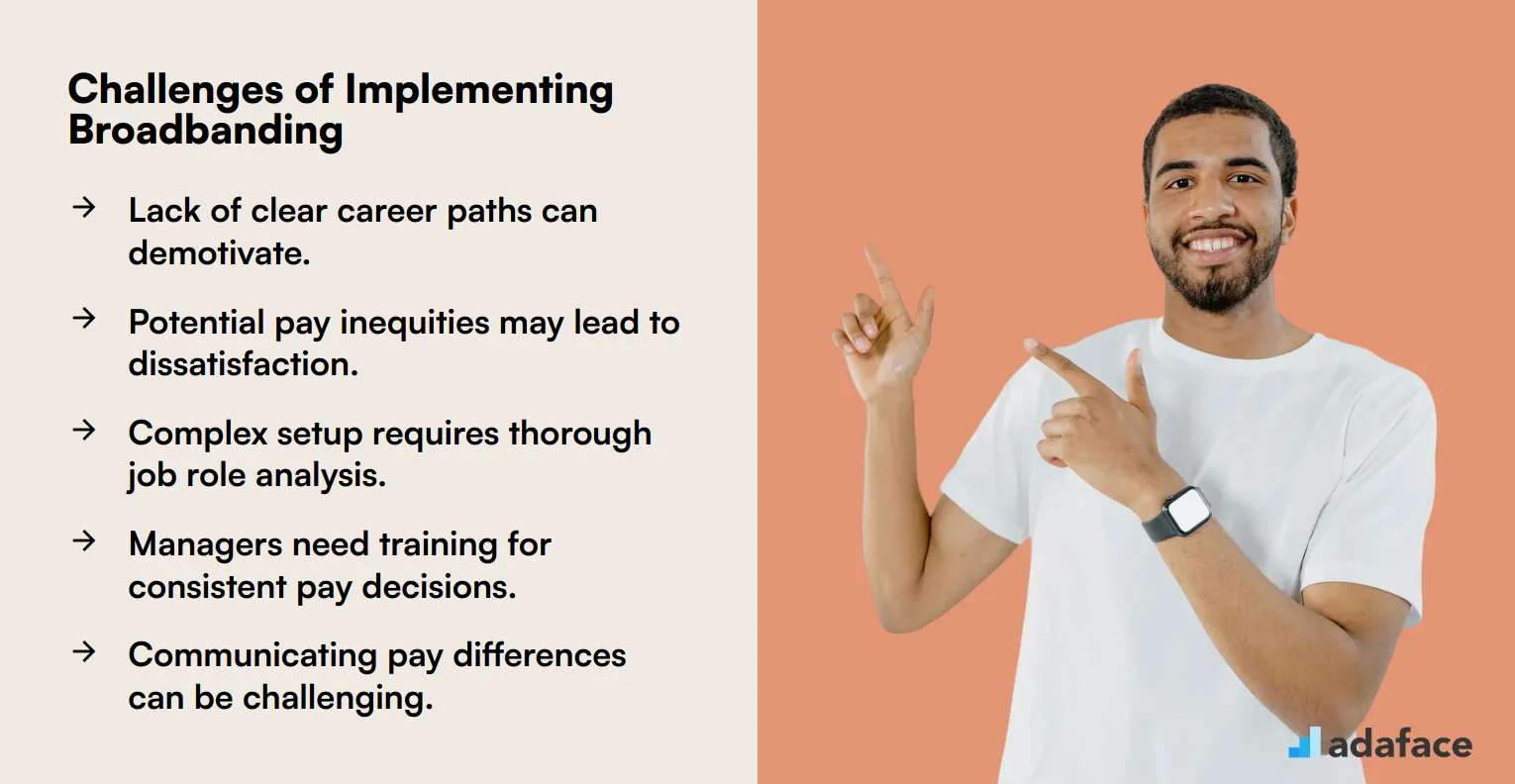Broadbanding is revolutionizing how organizations structure their compensation systems. It's a modern approach that simplifies pay grades and offers more flexibility in salary management.
For recruiters, understanding broadbanding is crucial to attract and retain top talent. This guide will explore the concept, its benefits, and how to implement it effectively in your organization.
Table of contents
What is broadbanding in compensation?
Broadbanding is a compensation strategy that simplifies traditional salary structures by consolidating multiple pay grades into fewer, broader bands. This approach offers more flexibility in employee compensation and career progression within an organization.
Instead of numerous narrow pay grades, broadbanding creates wider salary ranges that encompass multiple job levels or roles. This system allows for easier lateral moves and skill development without the need for frequent promotions or title changes.
Broadbanding can help organizations adapt to flatter hierarchies and promote a more agile workforce. It also simplifies salary administration and can reduce the focus on job titles, encouraging employees to develop a broader range of skills.
However, broadbanding may present challenges in defining clear career paths and managing salary expectations. Organizations must carefully design and communicate their broadbanding structure to ensure fairness and transparency in compensation decisions.
When implementing broadbanding, companies typically create 3-5 wide salary bands that cover various job families or levels. Each band has a minimum and maximum salary range, allowing for significant pay variation based on factors like performance, skills, and market conditions.
How broadbanding differs from traditional pay structures
Broadbanding represents a shift from traditional pay structures by offering wider salary ranges within fewer pay grades. This approach contrasts with the conventional model, which typically features narrow salary bands and numerous pay grades.
Traditional pay structures often result in rigid hierarchies, where employees may feel constrained by limited opportunities for salary progression. In contrast, broadbanding allows for greater flexibility and encourages skill development, as employees can move within a broader pay range without the need for promotion.
By minimizing the number of pay grades, broadbanding simplifies compensation management and reduces administrative complexities. This can lead to enhanced job satisfaction and retention, as employees perceive a more transparent and equitable pay system.
Broadbanding also supports a more agile workforce, as it aligns with modern organizational needs for flexibility and adaptability. This pay structure can be particularly beneficial for roles that require diverse skill sets, as it accommodates varied career paths and personal growth opportunities.
Overall, broadbanding offers a more dynamic approach to compensation, fostering a culture of continuous learning and development. It empowers employees to take control of their career trajectories, aligning personal goals with organizational objectives.
Advantages of implementing broadbanding
Implementing broadbanding in an organization offers several advantages for both employers and employees. One of the primary benefits is increased flexibility in talent management and career progression within the company.
Broadbanding simplifies job classifications and salary structures, making it easier for HR professionals to manage compensation. This streamlined approach can lead to reduced administrative costs and more efficient salary administration processes.
Employees benefit from broadbanding through enhanced career development opportunities and greater job mobility. The wider salary ranges allow for more frequent pay increases based on skill development and performance, without necessarily requiring a formal promotion.
Broadbanding can also foster a more collaborative work environment by reducing hierarchical barriers between job levels. This flattened structure encourages employees to take on new responsibilities and develop a broader skill set, potentially increasing overall productivity.
For organizations, broadbanding provides greater flexibility in recruiting and retaining top talent. The wider salary ranges allow companies to offer competitive compensation packages and adjust salaries more easily to match market rates or individual performance.
Lastly, broadbanding can support a more agile organizational structure, enabling companies to adapt quickly to changing market conditions and business needs. This flexibility can be particularly beneficial in fast-paced industries or during periods of organizational change.
Potential challenges with broadbanding
While broadbanding can offer flexibility in compensation structures, it's not without its challenges. One potential issue is the lack of clear career progression paths, which may demotivate employees seeking traditional promotions.
Another challenge is the potential for pay inequities within broad bands. Without careful management, employees performing similar roles might receive significantly different compensation, leading to dissatisfaction and potential legal issues.
Implementing broadbanding can also be complex and time-consuming. It requires a thorough analysis of job roles, market data, and internal equity considerations to establish fair and competitive pay ranges.
Managers may struggle with making pay decisions within broad bands, especially if they lack proper training or guidelines. This can lead to inconsistent pay practices across the organization and potential bias in hiring decisions.
Finally, broadbanding may create challenges in communicating compensation decisions to employees. Without clear job levels or titles, it can be difficult to explain pay differences or justify salary increases, potentially leading to transparency issues.

Steps to introduce broadbanding in your organization
To introduce broadbanding in your organization, start by assessing your current job classification system. This will help you identify which roles can be grouped into broader bands based on skills and responsibilities. Next, engage with key stakeholders, including HR, management, and employees, to gather insights and address concerns. It's important to communicate the benefits of broadbanding, such as flexibility in career progression and simplified pay structures. Develop a clear implementation plan that outlines timelines, responsibilities, and training needs. Finally, monitor the impact of broadbanding and make adjustments as needed to ensure it aligns with organizational goals and employee satisfaction.
Best practices for managing a broadband pay system
Managing a broadband pay system requires clear communication and transparency to ensure employees understand the pay structure. Regularly updating job descriptions and salary ranges helps maintain fairness and competitiveness in the market.
Training managers on how to effectively implement and manage the system is also important. This includes understanding how to address employee concerns and questions about pay progression.
It's beneficial to periodically review the broadband pay system to ensure it aligns with organizational goals and market trends. Involving HR professionals in these reviews can provide valuable insights into necessary adjustments.
Additionally, integrating performance management processes with the broadband pay system can enhance employee motivation. Clear performance metrics and feedback mechanisms can help employees understand how their efforts impact their pay progression.
Lastly, fostering a culture of internal promotion can encourage employees to develop their skills and advance within the organization. This not only aids in talent retention but also strengthens the overall workforce.
Conclusion
Broadbanding FAQs
- Simplifies salary administration
- Provides more flexibility in pay decisions
- Encourages lateral career moves
- Reduces the need for frequent promotions
- Aligns better with flatter organizational structures
Broadbanding can boost motivation by:
- Offering more opportunities for pay increases within a band
- Encouraging skill development and lateral moves
- Reducing focus on job titles and hierarchies
- Promoting a more flexible and dynamic work environment
Potential challenges include:
- Difficulty in explaining salary decisions to employees
- Risk of salary compression or inflation
- Possible perception of reduced career progression
- Need for robust performance management systems
- Initial complexity in transitioning from traditional structures
Recruiters can leverage broadbanding by:
- Highlighting flexibility in pay and career growth
- Emphasizing opportunities for skill development
- Showcasing a modern, less hierarchical workplace
- Offering competitive salary ranges within broad bands
- Discussing potential for lateral moves and diverse experiences

40 min skill tests.
No trick questions.
Accurate shortlisting.
We make it easy for you to find the best candidates in your pipeline with a 40 min skills test.
Try for freeRelated terms



